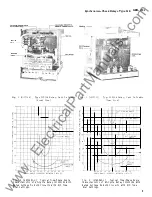
GEH-1791 Synchronism-Check Relays Type LJS
turbed.
If
the examination or tests indicate that
readjustment is necessary, refer to Section on
SERVICING.
VISUAL INSPECTION
Check the nameplate stamping to insure that
the Model Number and rating of the relay agree
with the requisition.
Remove the relay from its case and check that
there are no broken or cracked molded parts of
other signs of physical damage and that all screws
are tight.
Check that the short fingers are in the correct
location as indicated in Fig. 8 and Fig.
9
and
that the auxiliary brushes are properly adjusted
(see Fig. 12).
MECHANICAL INSPEC TION
1 . Check that the rotating element moves without
noticeable friction.
2. Remove the time dial locking screws and
check that the moving contact just touches
the stationary contact when the time dial is
set at zero.
The contact wipe should be
approximately 1/32".
3. Check that the control spring is not deformed
and the spring convolutions at No. 5 T .D.S.
are reasonably concentric .
ELECTRICAL TESTS
Connect the relay as shown in Fig. 10 and
check the following:
1 . C heck that the relay picks up with at least
1 1 5 volts, 60 cycle single-phase source con
nected to both operating coils with approximately
the time delay shown in Fig. 7.
2. Check that the relay picks up at a 20° closing
angle (or other closing angle is used) within
.±
3 degrees when connected to a 1 1 5 volt, 60
cycle source with rated voltages on both coils.
Check zero displacement pick up which should
agree with the value in Fig. 1 within
.±
10
percent.
3. With both coils connected to 1 1 5 volt source
with zero displacement, check that pick up
time agrees with values given in Figures 4
or 5 plus or minus 10 percent.
INSTALLATION PROCEDURE
If
after acceptance tests the relay is held in
storage before shipment to the job site, it is
r ecommended that visual and mechanical inspection
described under the section on ACCEPTANCE
TESTS be repeated before installation.
8
E LECTRICAL TESTS
Before the following electrical tests are made
the relay should be in its case, preferably mounted
in its permanent location.
A typical elementary diagram of external con
nections is shown in Fig. 1 1 .
The "B" contact
of 52 in series with only one coil circuit serves to
reset the disk and contacts promptly after the circuit
breaker closes, so that the normal delay is avail
able as soon as possible in case the breaker trips
again. Additional relays (undervoltage or reclosing)
may be considered desirable for prevention of
unlimited reclosures in case of one wire broken and
grounded or crossed with another phase.
The relay c losing angle should be set as
required for its permanent location which would
normally be 20 degrees.
Connect the relay as
shown in Fig. 10 and check that the relay picks up
at the proper phase angle plus or minus 3 degrees.
If
a phase angle meter or a phase shifter is
not available, it is possible to adjust the relay to
approximately the closing angle desired by means
of the connections and curve shown in Fig. 12A.
In
this test rated voltage is held on one circuit
(studs 7-8) and a reduced voltage is applied to the
other circuit (studs 5-6). The voltage connected
to studs 5-6 is adjusted until the synchronizing
check unit just closes its contact. The difference
between the two voltages should agree approximately
with the voltage given on the curve shown in Fig.
12A for the phase angle used (i.e. 24 volts for 20
degrees closing).
When using either connections shown in Fig. 10
or Fig. 12, check the operating time at 0 dis
placement with 1 1 5 volts on each coil using the
time dial setting of the permanent location. (See
Fig. 7 for nominal time delay values. )
PERIODIC CHECKS AND
ROUTINE MAINTENANCE
In
view of the vital role of protective relays
in the operation of a power system it is important
that a periodic test program be followed. It is
recognized that the interval between periodic checks
will vary depending upon environment, type of relay
and the user's experience with periodic testing.
Until the user has accumulated enough experience to
select the test interval best suited to his individual
requirements it is suggested that the following
points be checked at an interval of from one to two
years.
MECHANICAL
The mechanical checks described under the
section on ACCEPTANCE TESTS should be repeated.
www
. ElectricalPartManuals
. com



















